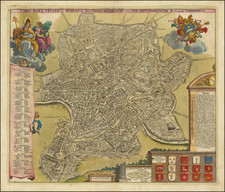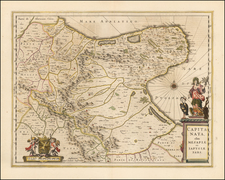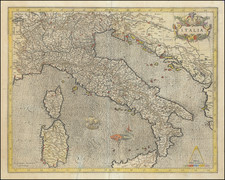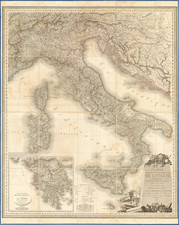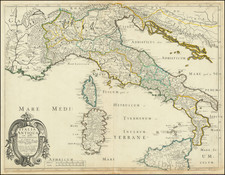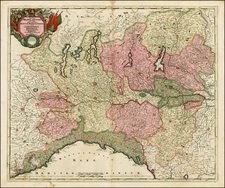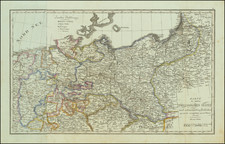One of the great early 18th Century Atlas Plans of Rome. The City on Seven Hills is shown in remarkable detail, right down to the streets, churches, buildings, fountains, piazzas, bridges, statues & gates. A number of boats are also shown in the Tiber. The 14 coats of arms of the city are shown along with a key featuring place names for each of the 14 parts. Two large decorative cartouches and several cherubs and architectural borders finish this spectacular town plan, which illustrates the fine style and strong engraving indicative of J.B. Homann's early work. A fabulous decorative piece in full attractive color.
Johann Baptist Homann (1663-1724) was a mapmaker who founded the famous Homann Heirs publishing company. He lived his entire life in Bavaria, particularly in Nuremberg. Initially, Johann trained to become a priest before converting to Protestantism and working as a notary.
In 1702, Johann founded a publishing house that specialized in engravings. The firm flourished, becoming the leading map publisher in Germany and an important entity in the European map market. In 1715, Johann was named Imperial Geographer to the Holy Roman Empire by Charles VI and made a member of the Prussian Academy of Sciences. Most importantly for his business, his reputation and contacts gained him imperial printing privileges which protected his publications and recommended him to customers. Johann is best known for this Grosser Atlas ueber die ganze Welt, or the Grand Atlas of the World, published in 1716.
After Johann died in 1724, the business passed to his son, Christoph (1703-1730). Upon Christoph’s early death, the company passed to subsequent heirs, with the name of the company changing to Homann Erben, or Homann Heirs. The firm continued in business until 1848.

